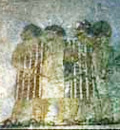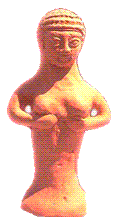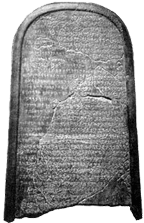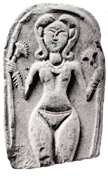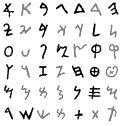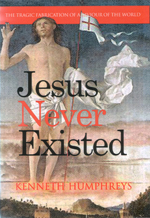Jew Who?
Asiatic traders, tomb of Beni Hassan, Middle Egypt. Jews – or not Jews?
'About the year 1000 B.C. there was nothing distinctive about the Jews ethnically, linguistically, politically or economically.'
N. Cantor (The Sacred Chain, p52)
Jews worship Queen of Heaven
"Then ... all the people who dwelt in Egypt ... answered Jeremiah: “We will not listen to you! We will ... burn incense to the Queen of Heaven and pour out drink offerings to her, as we have done, we and our fathers, our kings and our princes, in the cities of Judah and in the streets of Jerusalem. For then we had plenty of food, were well-off, and saw no trouble."
– Jeremiah 44.15-17.
The rambling, repetitive book of Jeremiah is a collection of disparate material assembled no earlier than the 6th century BC.
Jews worship Tammuz
'Then he brought me to the door of the gate of the LORD's house which was toward the north; and, behold, there sat women weeping for Tammuz.'
– Ezekiel 8:14.
The Babylonian god actually gives his name to the 4th month of the Jewish religious year.
Jews Worship Anat-Bethel
Jewish mercenaries, garrisoned at Elephantine on the upper Nile from the early 7th century BC, maintained their own Temple.
As a "treasurer's report" records, the Judaean soldiers worshipped both Yahweh (Yahu) and his Canaanite girlfriend Anat, despite the prohibitions of Deuteronomy.
Mrs God
"At two sites, Kuntilet Ajrud in the southwestern part of the Negev hill region, and Khirbet el-Kom in the Judea piedmont, Hebrew inscriptions have been found that mention 'YHWH and his Asherah', 'YHWH Shomron and his Asherah', 'YHWH Teman and his Asherah'.
These inscriptions, from the 8th century BCE, raise the possibility that monotheism, as a state religion, is actually an innovation of the period of the Kingdom of Judea, following the destruction of the Kingdom of Israel."
– Ze'ev Herzog (Prof. Archaeology and Ancient Near Eastern Studies at Tel Aviv University)
Symbolically, Asherah was portrayed as a heifer and Yahweh as a bull.
First mention of Israelites by their neighbours
The Moabite Stele - Large slab of basalt that records King Mesha of Moab's defeat of Israel "which hath perished forever".
– 9th century BC (Louvre, Paris)
Back Projection ...
"The Bible writers projected backwards into time the kind of political rivalry that was happening in their own day [6th c BC] in order to explain that rivalry and perhaps justify the Israelite position over current border disputes."
Magnus Magnusson (The Archaeology of the Bible Lands - BC, p76)
Race is a sensitive subject. To use the word almost invites the charge of racism. Yet to understand the rise of Christianity one must come to terms the people who were its original authors – the Jews.
The Myth of the Jewish ‘Race’
The weight of evidence suggests these original ‘Hebrews’ coalesced during the bronze age from successive migrations, some from the periphery of the Nile delta (in Egyptian, ‘Peru or apiru meant a labourer) but most from across the Jordan and Euphrates rivers. In their own semitic tongue, habiru meant ‘beyond’, suggesting an origin elsewhere. In Babylonian script khabiru referred to a class of slaves. As a people, therefore, the Hebrews combined Mesopotamian and Egyptian stock, almost certainly drawn from the lowest social order, conceivably including runaway slaves. One migration, at least, brought with it a mountain/sky god – Yahweh – destined for higher things.
Settlement in Canaan As barbarous newcomers to what was the land of Canaan, these semites (speakers of a tongue common to Syrians, Arabs and Mesopotamians) took up migratory occupation of the less fertile hill-country of the interior. Neither their limited sub-culture – an illiterate donkey nomadism; nor their social organisation – patriarchal and authoritarian – distinguished them from other tent-dwelling pastoralists. These early, polytheistic, Hebrews scratched an existence in an unpromising land on the fringes of the major civilisations, occasionally moving with their animals into the Nile delta in times of draught. It seems as if they were joined, over time,by outcasts or refugees from the more sophisticated Canaanite (Phoenician) coastal cities. ‘Israel emerged peacefully and gradually from within Canaanite society ‘ concluded Karen Armstrong, the noted religious scholar. (A History of Jerusalem, p23]
The Canaanite migrants brought with them cultic practices and images of their traditional gods. A major Canaanite god was El, and the phrase ‘El has conquered’ gives us the word Isra’el. The Canaanite god El had a ghostly presence in a host of Jewish heroes: Dan-i-El; Ezek-i-El; Sam-u-El, Ish-ma-El, El-i-jah, El-o-him, etc. God-inspired names were common throughout the west-Semitic language region. Other Canaanite gods included Baal (a storm god) – also honoured in a host of Hebrew names, Asherah (a fertility goddess, consort of El), Shalem (a Syrian sun god – later to be honoured in the name Jeru’salem ), Milcom, Chemosh, etc. Ru’shalimum is mentioned in records of the Pharaoh Sesostris III (1872 - 1847 BC) – the settlement actually pre-existent long before the tribe of Hebrews made it their own. The site then appears to have been unoccupied for three hundred years until the Jebusites (otherwise known as Kereti or Peleti – Cretans or Philistines) arrived.
Polytheistic Jews? YHWH and his Asherah
Influenced by these Canaanite cults, but devoid of artistic or metal working skills of their own, the early Hebrews adopted a way of honouring their god of choice by genital mutilation. This sometime practice of the Egyptian priesthood became, for the ‘Jews’, a tribal obligation, part of the male regenerative organ offered as a blood sacrifice to the ‘jealous’ god Yahweh. Other gods were worshipped but Yahweh demanded precedence.
Thus though the Hebrews were not a race, the males at least acquired a distinctiveness from other Semitic tribesmen who did not practice circumcision. Women, regarded as mere chattels, were spared this mutilation. In this period of proto-Judaism, polygamous males acted as ‘priests’ for their extended families and kinship groups and exercised absolute authority over wives and children. At some point in the tenth century BC the Hebrews were completely overwhelmed by the more advanced Philistines, moving down from the north. Armed with iron weapons and deploying chariots the Philistines scattered the primitive Hebrew nomads into the hill country and a few austere places in the Jordan River valley. The various Hebrew clans had no single warlord but were led by tribal elders and shamans. The backward Hebrews remained under the sway of their shamanic ‘judges’ to a much later date than neighbouring peoples. Theirs was a harsh culture of ‘scapegoat’ sacrifice and collective and inherited guilt (‘eye for an eye’ vengeance). As marginalised pastoralists they were acutely xenophobic and demonized the city dwellers and farmers. With the ebb and flow of empires over centuries, and the endless movement of peoples, we might have expected this marginal tribe to have passed into history, along with countless other peoples, assimilated into a greater multitude.
Sacred History But we have a story, a tale of tribal fidelity – with frequent, and instructive, lapses – to a protector god Yahweh, who had chosen this ‘people’ as his very own. For them, he has a divine purpose. In particular, their migration into Canaan is given an heroic re-interpretation. No longer do we have piecemeal migration over centuries but a single glorious conquest by a cohesive people. The ‘idolatrous’ city dwellers (of ‘Jericho’, etc.) get their comeuppance and the whole land is promised to the Jews in perpetuity. They have, it would seem, arrived as a single group from Egypt, released from slavery by divine intervention.
Records one historian,
The original Hebrew/Canaanite occupants of Palestine did pass into history. Many, including the so-called ‘lost tribes’ of Israel (those living in northern Palestine) were assimilated by Assyrian conquerors during the eighth century. But the ‘victors’, a Persian-sponsored priesthood who settled in Judaea in the 6th century BC, wrote a sacred history, known to the Jews as the Torah (or Pentateuch ) and to the Christians as the first 'five books' of the Old Testament. Together with the 'Prophets' and 'Wisdom' literature this voluminous text purports to be an account of the trials and tribulations of the Jews through the previous two millennia. Rather oddly, its detail and obvious accuracy peters out the closer it approaches the time when it was actually written. Joshua, supposedly on the rampage in the thirteenth century BC gets vast reportage, whereas several 7th century kings known to history are omitted. Indeed, the four hundred years between the last book of the Old Testament (the 5th century Malachi) and the first book of the New Testament echo in a biblical silence. No biblical text gives the conquest of Palestine by Alexander the Great (in 323 BC) a mention. Ptolemaic Egypt’s loss of her Palestinian provinces to Syria in 198 BC is unrecorded. 'Minor' personages like Julius Caesar and Pompey the Great are overlooked. And the books of Maccabees – which should tell us the ‘recent’ story of the successful Jewish rebellion against Greek rule in the second century BC – are so blatantly filled with error and incoherence that even biblical editors shunted them into the ‘Apocrypha’ or omitted them entirely. But of course we are not speaking of history but rather, of sacred testimony, designed to control, justify and inspire. Anyone can be factual. In the Bible we have a book with a purpose.
Sources:
Copyright © 2004
by Kenneth Humphreys.
|
|||||||||||||||||||||||||||||||||||||||||||||||||||||||||||||||||||||||||||||||||||||
